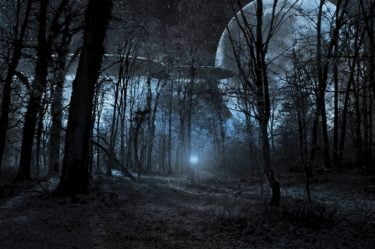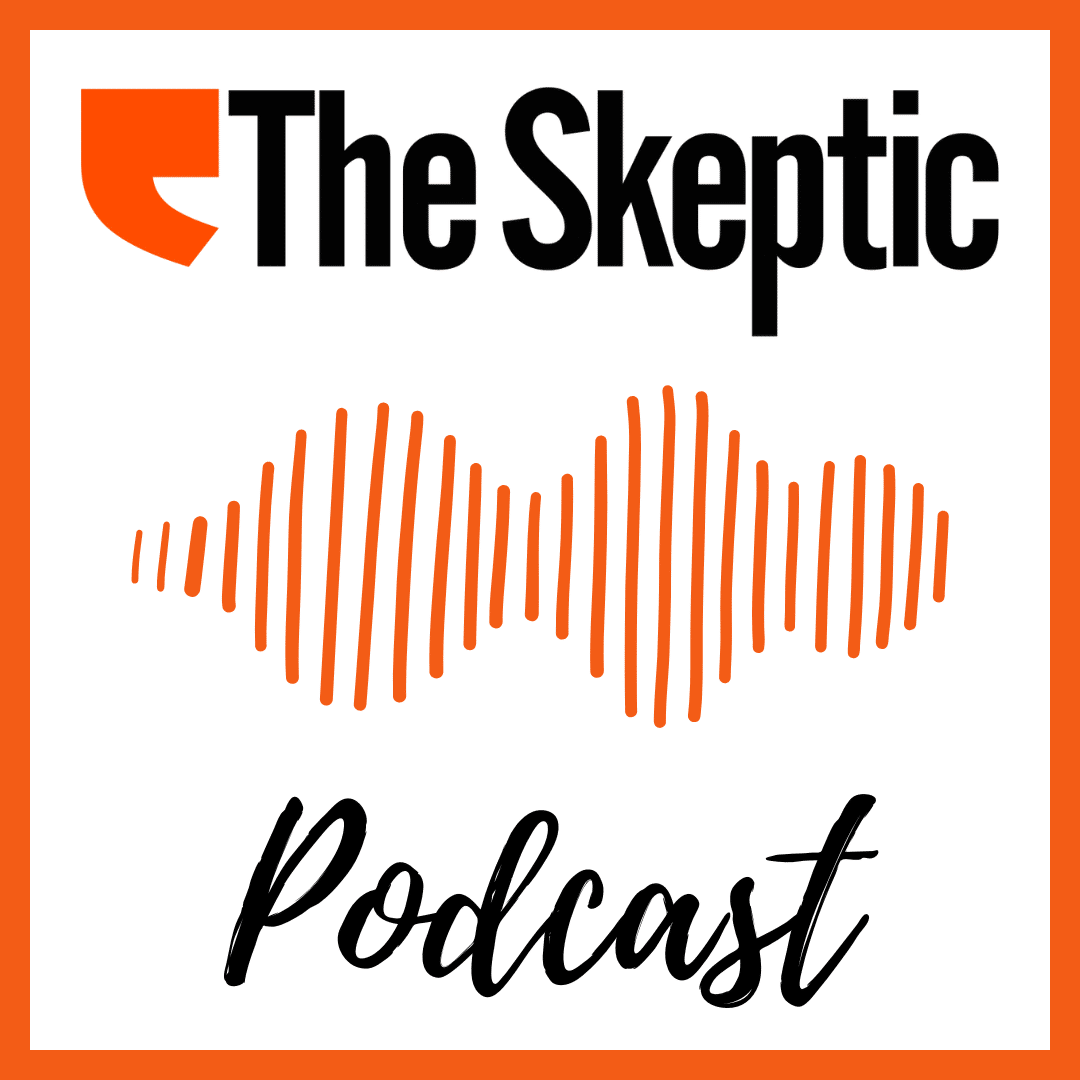Over recent months, as the world has watched in grim fascination the events leading up to and following the US presidential election, the pronouncements from supporters of the unfounded far-right QAnon conspiracy have been of particular interest to many of us. Quite a few psychologists and other social scientists have, I suspect, also been reflecting upon a classic study of a UFO cult from the 1950s. What’s the connection, I hear you ask? I’ll tell you soon. First, in case you have been living under a rock without any access to news media for the last couple of years, I had better briefly summarise the beliefs of QAnon supporters. If you are already up to speed on the basics of QAnon, just skip the next paragraph.
The conspiracy is called “QAnon” because many of the wild speculations of its followers are based upon their interpretations of the vague and ambiguous messages appearing on the internet from an anonymous source referred to as “Q Clearance Patriot” – or simply as “Q” for those on first-name terms. Q, who first posted in October 2017 (but has been noticeably quiet of late), is said to be someone working at the heart of the US government. Essentially, up until very recently, QAnon supporters were all convinced that then-President Donald Trump was engaged in a covert operation to expose a hidden Satanic cabal of powerful individuals who were engaged in evil acts of paedophilia, child-trafficking, cannibalism and so on. This group, including the likes of Hillary Clinton, Barack Obama, and George Soros, were said to be plotting a coup d’état against Trump, but Trump, whom they viewed as almost God-like, was said to be always one step ahead of them. Indeed, they confidently predicted that the “Storm” was coming. This was to be a day of reckoning when literally thousands of left-wing Satanists would be arrested and get their just desserts for their diabolical actions.
So what has all this to do with UFO cults? The connection, to my mind, is the concept of cognitive dissonance and its relevance to failed predictions. Cognitive dissonance is the idea, first put forward by social psychologist Leon Festinger back in the 1950s, that when we hold two dissonant cognitions – in other words, beliefs, attitudes, or actions – that contradict each other, this is psychologically uncomfortable and we will be motivated to resolve this dissonance. A classic example is someone who enjoys smoking but knows that experts claim that it causes serious medical problems. There are two ways that the dissonance can be resolved. One is the route that I took. You can just give up smoking. But that is easier said than done. If it proves too difficult, you might opt for the other route: come up with reasons why the advice can be ignored, for the time being at least, e.g., “I’ll give up after I’ve got X out the way” (where X = forthcoming stressful event) or the classic, “Well, I might get run over by a bus tomorrow”, and so on.
Paradoxically, Festinger’s theory predicts that, in certain circumstances, disconfirming evidence can actually increase belief in a claim. The conditions required are described on Wikipedia as follows:
- A belief must be held with deep conviction and it must have some relevance to action, that is, to what the believer does or how he or she behaves.
- The person holding the belief must have committed themselves to it; that is, for the sake of their belief, they must have taken some important action that is difficult to undo. In general, the more important such actions are, and the more difficult they are to undo, the greater is the individual’s commitment to the belief.
- The belief must be sufficiently specific and sufficiently concerned with the real world that events may unequivocally refute the belief.
- Such undeniable disconfirmatory evidence must occur and must be recognised by the individual holding the belief.
- The individual believer must have social support. It is unlikely that one isolated believer could withstand the kind of disconfirming evidence that has been specified. If, however, the believer is a member of a group of convinced persons who can support one another, the belief may be maintained and the believers may attempt to proselytise or persuade non-members that the belief is correct.

This is where the UFO cult comes in (and thank you for your patience). As Festinger describes in his book When Prophecy Fails, co-authored with Henry W. Riecken and Stanley Schachter, the theory was put to the test by way of a rather unusual investigation. In 1954, a Chicago-based housewife named Dorothy Martin (name and location changed in the book) had built up a small following who accepted that she was receiving messages from superior beings on the planet “Clarion” via automatic writing. Festinger became aware of this when the local paper ran a story on its back page with the headline, “PROPHECY FROM PLANET CLARION CALL TO CITY: FLEE THAT FLOOD. IT’LL SWAMP US ON DEC. 21. OUTER SPACE TELLS SUBURBANITE.” Apparently, the true believers were to be saved from this looming disaster by flying saucers. Acting upon this information, some of the followers had given up work and given away all of their possessions on the assumption they would not need them after the designated date.
On the assumption that the flood would not actually happen, Festinger and his colleagues, along with some hired helpers, infiltrated the group in order to observe how the cult members would deal with the ensuing cognitive dissonance when, as they expected, the flood failed to materialise. They were present at the home of Mrs Martin, along with eleven true believers, as the designated hour approached. They had been told that an alien would show up at midnight and escort them to a waiting spaceship. A further eleven cult members were unable to join those at Mrs Martin’s home but had been informed by her that they need not worry as the flying saucers would pick them up from wherever they happened to be.
As midnight came and went, Mrs Martin reported that she had received a message that there would be a slight delay. Nerves frayed over the following hours, with ET still failing to put in an appearance. At 4 am, Mrs Martin began to cry. But then – hallelujah! – at 4:45 am, she received another message telling her that the disaster had been averted directly as a result of the faith that the group had shown!
In light of the clear evidence that the original prediction had failed, the followers could resolve the cognitive dissonance in one of two ways. They could either abandon their belief in Mrs Martin’s claims altogether or they could accept the rationalisation presented by Mrs Martin and thus end up believing even more strongly in her claims. After all, the strength of their faith had already prevented a flood, hadn’t it?
Festinger had predicted that individual believers would need to have social support in order to maintain and even strengthen belief in the light of clear disconfirming evidence. Those who were together at Mrs Martin’s residence did indeed demonstrate such increased belief. Whereas, prior to the disconfirmation, members had been reluctant to talk about their beliefs to the media, they now were only too willing to spread the good news. As for those who were not part of that group on the fateful night, they resolved their cognitive dissonance by quietly and painfully accepting that they had been mistaken to believe in Mrs Martin at all and leaving the cult.
When it comes to failed predictions, QAnon’s record is pretty impressive. Their Wikipedia entry lists no less than 17 failed predictions – and six of those are marked as “multiple predictions”. These include predicting that the Trump military parade “would never be forgotten” (it was cancelled), that John McCain would resign from the US Senate, that Mark Zuckerberg would leave Facebook, that Jack Dorsey would be forced to resign from his role as CEO of Twitter, and that Pope Francis would be arrested on felony charges. Some of the events were predicted to take place on or around a specific date. A “smoking gun” video of the hated Hillary would be made public in March 2018.There was to be a car bomb in London around 16 February 2018 following mass suicides of Trump’s enemies on 10 February 2018.
Maybe those particular failed predictions could be explained away as understandable misinterpretations of Q’s vague messages. But as the date of the election drew nearer many QAnon supporters became increasingly confident that the “Storm” was imminent (this was despite a previous failed prediction that it would occur on 3 November 2017). There were many other predictions made around this time. Trump would win the election in every state. He didn’t. Okay, but trust the Plan, he will win overall. He didn’t. Don’t worry, this is all part of the Plan. He wanted to lose so that he can prove in court that the Democrats won through fraudulent means. The courts, with one single exception, rejected Trump’s legal challenges against the election results. With each failed prediction, greater faith in the conspiracy was required to accept the increasingly outlandish explanations offered for that failure.
On 6 January 2021, Trump addressed his followers and encouraged an insurrection, resulting in the storming of the Capitol building. To many true believers, it really must have looked like the “Storm” was becoming a reality. But after a few hours, the building was cleared, martial law had not been declared, and President Trump had distanced himself from the actions of his supporters. Reactions varied amongst QAnon supporters. By now, some of them were beginning to question the whole conspiracy. Many others though still believed that this was all part of Trump’s cunning Plan.
Time was running out. Trump would cease to be President on 20 January 2021, the day of Joe Biden’s inauguration. Clearly then, that must be the real day of the “Storm”. Of course, as we all now know, the event passed off peacefully. Joe Biden is now the President of the USA. The “Storm” did not break.
![A QAnon poster on a fence with the letters "WWG1WGA" which stands for where we go one, we go all. [CC 2.0]](https://www.skeptic.org.uk/wp-content/uploads/2021/02/QAnon_poster_48555555282-375x375.jpg)
So, where now for QAnon supporters? These days, only the most foolish would make confident predictions about future events but, for what it is worth, this is what I think is most likely to happen: Those supporters for whom QAnon became central to their very identity will most likely double down and become even more committed to the cause. This would include those who have attended Trump rallies in the past, carrying QAnon flags and banners, and of course many of those who were directly involved in the invasion of the Capitol building on 6 January, as well as those whose support for QAnon has resulted in broken relationships with friends and family. By now, faith in the conspiracy can only be maintained by accepting the most twisted logic. In the words of a recent Washington Post article:
QAnon promoters have in the past day held up an incoherent set of new theories to explain away Trump’s anticlimactic exit from Washington: that the military is in control of the country, not Biden; that Biden and Trump have switched faces; that Biden’s inauguration was illegitimate, and that the real one (for Trump) would take place in March; or that Biden has been in on the QAnon plan all along.
Others, those who were less committed to begin with, will realise that the QAnon conspiracy theory was an illusion and will turn away from it altogether. If we’re lucky, they may abandon belief in unfounded conspiracy theories altogether. If we’re not, they may simply latch on to a different unfounded conspiracy that aligns nicely with their far-right attitudes.



